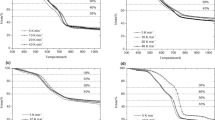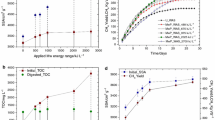Abstract
In this study, thermal analysis in differential scanning calorimetry associated to Fourier self-deconvolution (FSD) of infrared spectra was applied to the study of anaerobic digestion of the organic fraction of domestic solid waste and sewage sludge mixed in 1:1 ratio under mesophilic and thermophilic conditions. Curves showed an exothermic peak in the high-temperature range and a number of endothermic and/or exothermic peaks in the low- and medium-temperature range. The high-temperature exotherm was a common feature on curves of all samples. Digestates evidenced a shift of this exotherm toward higher temperature with respect to both substrates and feed-in materials as a result of a greater chemical complexity attained by organic matter (OM) during the process. A further shift toward higher temperature values was observed on digestates obtained under thermophilic conditions with respect to digestates obtained under mesophilic conditions. This result was associated to a higher recalcitrance of digestates produced under more drastic conditions. Based on evidence obtained by FSD spectra, the exotherm in the medium-temperature range was assigned to combustion of carbohydrates and to loss of aliphatic structures and carboxylic groups. Enthalpy data associated to the high-temperature exotherm were used to differentiate feed-in materials and their corresponding digestates and to distinguish digestates obtained under different operative conditions.








Similar content being viewed by others
References
Goldemberg J, Coelho S. Renewable energy-traditional biomass vs modern biomass. Energy Policy. 2004;32(6):711–4.
de Vos R. Defining biomass: which type of biomass will count as renewable energy? ReFocus. 2006;7(5):58–9.
Oliveira LS, Franca AS. From solid biowaste to liquid biofuel. In: Ashworth GS, Azevedo P, editors. Agricultural wastes, Chapter 11. Hauppauge, NY: Nova Science Publishers; 2009.
Alvarez JA, Otero L, Lema JM. A methodology for optimizing feed composition for anaerobic co-digestion of agro-industrial wastes. Biores Technol. 2010;101(4):1153–8.
Gomez X, Cuetos MJ, Tartakovsky B, Martinez-Nunez MF, Moran A. A comparison of analytical techniques for evaluating food waste degradation by anaerobic digestion. Bioprocess Biosyst Eng. 2010;33:427–38.
Cuetos MJ, Gomez X, Otero M, Moran A. Anaerobic digestion of solid slaughterhouse waste: study of biological stabilization by Fourier transform infrared spectroscopy and thermogravimetry combined with mass spectrometry. Biodegradation. 2010;21:543–56.
Nges IA, Liu J. Effects of solid retention time on anaerobic digestion of dewatered sewage sludge in mesophilic and thermophilic conditions. Renew Energy. 2010;35(10):2200–6.
Drussi Z, D’Orazio V, Provenzano MR, Hafidi M, Outmane A. Study of the biodegradation and transformation of olive-mill residues during composting using FTIR spectroscopy and differential scanning calorimetry. J Hazard Mater. 2009;164:1281–5.
Provenzano MR, Albuzio A, D’Orazio V. Spectroscopic and thermal investigations on compost improved by iron salt addition. J Agric Food Chem. 2005;53:374–82.
De Olivera SC, Provenzano MR, Santiago-Silva MR, Senesi N. Maturity degree of composts from domestic solid wastes evaluated by differential scanning calorimetry. Environ Technol. 2002;23:1099–105.
Provenzano MR, Ouatmane A, Hafidi M, Senesi N. Differential scanning calorimetric analysis of composted materials from different sources. J Therm Anal Calorim. 2000;61:607–14.
Provenzano MR, Senesi N. Thermal properties of standard and reference humic substances by differential scanning calorimetry. J Therm Anal Calorim. 1999;57:517–26.
Leoboeuf EJ, Zhang L. Evolution of concepts of environmental natural nonliving organic matter. In: Senesi N, Xing B, Huang PM, editors. Biophysico-chemical process involving natural nonliving organic matter in environmental system. Hoboken, NJ: Wiley & Sons, Inc.; 2009.
Mothè C, Miranda I. Characterization of sugarcane and coconut fibers by thermal analysis and FTIR. J Therm Anal Calorim. 2009;97(2):661–5.
dos Reis Orsini R, Moscardini Filho E, Pita Mercuri L, do Rosario Matos J, de Carvalho FMS. Thermoanalytical study of inner and outer residue of coffee harvest. Applications on biomass. J Therm Anal Calorim. 2011;106:741–5.
Barros N, Salgado J, Villanueva M, Rodriquez-Añón J, Proupin J, Feijóo S, Martín-Pastor M. Application of DSC–TG and NMR to study the soil organic matter. J Therm Anal Calorim. 2011;104(1):53–60.
Fernández JM, Plante AF, Leifeld J, Rasmussen C. Methodological considerations for using thermal analysis in the characterization of soil organic matter. J Therm Anal Calorim. 2011;104(1):389–98.
Gomez X, Cuetos MJ, Garcia AI, Moran A. An evaluation of stability by thermogravimetric analysis of digestate obtained from different biowastes. J Hazard Mater. 2007;149:97–105.
Sanchez M, Gomez X, Barriocanal G, Cuetos MJ, Moran A. Assessment of the stability of livestock farm wastes treated by anaerobic digestion. Int Biodeterior Biodegr. 2008;62:421–6.
Barros N, Ramajo B, García JR. The effect of solid-liquid effluents from anaerobic digesters on soil microbial activity. A calorimetric study. J Therm Anal Calorim. 2009;95(3):831–5.
Barros N, Salgado J, Villanueva M, Rodriguez J, Proupin J, Feijòo S, Martin-Pastor M. Application of DSC–TG and NMR to study the soil organic matter. J Therm Anal Calorim. 2011;104:53–60.
APHA. Standard methods for the examination of water and wastewater. 21st ed. Washington, DC: American Public Health Association; 2005.
Salgado J, Mato MM, Vázquez-Galiñanes A, Paz-Andrade MI, Carballas T. Comparison of two calorimetric methods to determine the loss of organic matter in Galician soils (NW Spain) due to forest wildfires. Thermochim Acta. 2004;410:141–8.
Marhuenda-Egea FC, Martinez-Sabater E, Jorda J, Sanchez-Sanchez A, Moral R, Bustamante MA, Paredes C, Perez-Murcia MD. Evaluation of the aerobic composting process of winery and distillery residues by thermal methods. Thermochim Acta. 2007;454:135–43.
Gomez X, Cuetos MJ, Garcıa AI, Moran A. Evaluation of digestate stability from anaerobic process by thermogravimetric analysis. Thermochim Acta. 2005;426:179–84.
Peuravuori J, Paaso N, Pihlaja K. Kinetic study of the thermal degradation of lake aquatic humic matter by thermogravimetric analysis. Thermochim Acta. 1999;325:181–93.
Capana AS, Martins QV, Crespi MS, Ribeiro CA, Barud HS. Thermal behavior of residues (sludge) originated from Araraquara water and sewage treatment station. J Therm Anal Calorim. 2009;97:601–4.
Otero M, Calvo LF, Estrada B, Garcia AI, Moran A. Thermogravimetry as a technique for establishing the stabilization progress of sludge from wastewater treatment plants. Thermochim Acta. 2002;389:121–32.
Wu H, Zhao Y, Long Y, Zhu Y, Wang H, Lu W. Evaluation of the biological stability of waste during landfill stabilization by thermogravimetric analysis and Fourier transform infrared spectroscopy. Bioresour Technol. 2011;102:9403–8.
Ferrasse JH, Chavez S, Arlabosse P, Dupuyc N. Chemometrics as a tool for the analysis of evolved gas during the thermal treatment of sewage sludge using coupled TG–FTIR. Thermochim Acta. 2003;404:97–108.
Grube M, Linb JG, Leeb PH, Kokorevicha S. Evaluation of sewage sludge-based compost by FT-IR spectroscopy. Geoderma. 2006;130:324–33.
Barth A. The infrared absorption of amino acid side chains. Prog Biophys Mol Biol. 2000;74:141–73.
Smidt E, Lechner P. Study on the degradation and stabilization of organic matter in waste by means of thermal analyses. Thermochim Acta. 2005;438:22–8.
Author information
Authors and Affiliations
Corresponding author
Rights and permissions
About this article
Cite this article
Provenzano, M.R., Daniela Malerba, A., Buscaroli, A. et al. Anaerobic digestion of municipal solid waste and sewage sludge under mesophilic and thermophilic conditions. J Therm Anal Calorim 111, 1861–1870 (2013). https://doi.org/10.1007/s10973-012-2598-6
Received:
Accepted:
Published:
Issue Date:
DOI: https://doi.org/10.1007/s10973-012-2598-6




